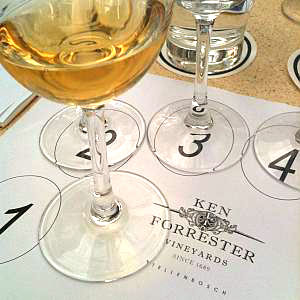SA has been famous for producing sweet dessert wines since the 18th century – Jane Austen mentioned sweet wines of Constantia in her novels and there is a well-documented history of exports to the UK and Europe which reached its peak of 1,000,000 gallons in the mid 1900’s. Sweet wine styles include ‘ports’ (soon to re-labelled ‘Cape Ruby’ ‘Cape Tawny’ etc), jerepigo’s and muscadels along with natural sweet wines, all the way up to the luscious and long-lived Noble Late Harvest styles.
SA dessert wines regularly win awards all over the world, garner far more than their fair share of Platter 5 Stars (including White Wine of the Year for the Badsberg Badlese), are held in high regard by wine critics and journalists – so why don’t we drink them? I’m as bad as the next person – I love a glass of dessert wine when I drink it, but I never keep a bottle in the fridge and never think to open any.
Luckily for producers of the finest sweet wines, this seeming lack of support isn’t a problem because they generally can’t make enough to meet demand anyway! That was certainly the message from Chenin King, Ken Forrester at a vertical tasting of ten years of his ‘T’ Noble Late Harvest at the Mount Nelson recently.
In fact, it will probably be the only tasting ever to go right back to the first vintage of 2000, simply because there is no stock left anywhere. The reason why there is so little becomes clear as Ken talks about how it is made – his pickers are only allowed to pick one single bunch of grapes from each vine so they must decide which is the best (in terms of having the most botrytis) and the rest is discarded.
Sometimes the pickers go through the vineyard up to 15 times in order to get a bunch at the correct degree of ripeness and rot. As each new batch of grapes arrives, it is pressed and then added to the already-fermenting juice which helps keep the ferment active and adds extra layers of complexity. The result is a rich wine, yet one with plenty of balancing acidity and not too much sugar – unlike other growers, Ken picks on only the 4th day of botrytis, before the grapes have turned completely to raisins, in order to retain some freshness in the wine.
The ‘T’ is named after Ken’s wife, Theresa and when it can be made (botrytis doesn’t always occur), it is often sold out almost instantly. The current vintage is 2009 and is available from the farm at R195 a half bottle. Here are some notes on some of the earlier vintages:
2008 ‘T’ Noble Late Harvest
Light, flowery flavours with underlying honey and caramalised nuts. Finishes with a lick of toffee oak.
2006 ‘T’ Noble Late Harvest
Upfront aromas of baked naartjies and grapefruit gives way to lots of nuts – almonds and hazelnuts finishing with coffee and toffee. Dessert in a glass
2005 ‘T’ Noble Late Harvest
Powerful and intense with plenty of golden sultanas and baked fruitcake notes interspersed with honey and toffee. Endless finish, lots of time to come.
2000 ‘T’ Noble Late Harvest
Hot toffee sauce with almond pastry, buttery notes and baked fruitcake. Mid-palate of baked apple tarte tatin and a rich finish.

